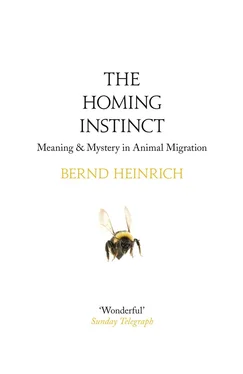Grasshoppers.One of the best-known insect dispersers, the “migratory locust” (the grasshopper, Schistocerca gregaria ), engages in some of the most spectacular mass movements in the animal kingdom. On the African continent, this species has been famous since biblical times. Swarms of the “locust” have blackened the skies, and as those in the vanguard settle onto the earth and consume every green thing where they land, the rest fly over them until they reach more green, while those behind then take flight and do the same, and so a horde of hundreds of millions moves along, stripping all vegetation in its path. Predators cannot put a dent in those hordes. Additionally, the migratory locust is distasteful to potential predators because when it migrates, it is not choosy about what it ingests and takes up toxins from poisonous plants, which it incorporates into its tissues. The grasshoppers’ bright red-orange and yellow coloration, like that of many insects including the monarch butterfly, reminds potential predators of its distastefulness.
Nymphs and adults of the two phases of the migratory grasshopper
Although this distinctively colored grasshopper appears to arrive suddenly, it is often there all along, but in a different guise. It has a green solitary grass-fed form that blends in with its food and that is palatable to predators. For a long time scientists thought that the grasshopper “migrants” that appeared so suddenly were a unique species, one arriving from an unknown origin and heading for an unknown destination. Now we know that the migrants are a “phase” of a common species that changes its color, form, and behavior in response to crowding. Proof comes from experiments: to create these “migrants” from isolated individuals one takes a nymph (immature stage), puts it in a jar, and has a motor-driven brush tickle it continuously. The constant tickling mimics the crowding, which in the case of S. gregaria is the signal evolution has “chosen” to trigger the nervous system to alter the hormones that result in development into the restless migratory phase of a different color, wing length, and behavior. It is a good example that shows environment is “everything,” or from another perspective, it’s all about genetics.
Migratory-phase locusts are highly irritable and will jump up and follow a crowd flying over it. This behavior removes the grasshoppers from an area that is overpopulated and brings them to new land where conditions are conducive to feeding, egg-laying, and growth of their offspring. Although the grasshoppers could have no knowledge of where such a distant but good place might be, they migrate to it as if they do.
The grasshoppers reach a consensus. It is a sensible one, although it involves no thinking and no discussion. They simply fly up to join the crowd, which follows the prevailing winds. Eventually these winds meet air from an opposite direction and, when moist tropical air rises into cooler altitudes, rain precipitates out of the resulting clouds, depositing the grasshoppers to earth along with the rain. As the ground is watered and softened, the grasshoppers can shove their abdomens into the soil to lay their eggs. The new nymphs hatch just as new food starts to sprout. Their homing (or “dispersal”?), which has ended at this good place for them to reproduce, is now complete.
Aphidslive in crowded “colonies” on plants into which they insert their mouthparts, much as mosquitoes puncture skin, except that they imbibe plant sap instead of blood and may stay plugged in at the same spot for most of their life spans. One might suppose they could not or would not migrate. But, like the migratory grasshoppers, they may travel possibly hundreds of kilometers. Nobody knows for sure how far; it depends on the prevailing winds.
Sedentary aphids already on good food do not leave to seek, or even require, mates. Instead, they switch to virgin births after a sexual migratory phase. Daughters then settle directly next to mother, and so on and on for many generations as the colony grows. And then, cued by the shortening of the days in the late summer and fall when the food supply runs out, the aphids’ offspring take a different developmental route. Because of changing day length and/or food, the nymphs on their final molt grow wings and become sexual. Frail and weak-winged they are, but an aphid is light and carried by the wind much like the seed of a dandelion or poplar tree, or a baby spider on a thread of silk. I usually see them in September when they appear like flecks of white lint floating erratically in the air.
To reach wind the aphids fly or are wafted up. Eventually, they don’t fight the wind but drift along and settle somewhere back down to earth. On their descent, assisted by their wings, they head toward anything colored light green. This color (unless they are tricked by pieces of green paper coated with sticky glue left by an insect physiologist studying them) is likely to be associated with their favorite food, fresh plant growth. After landing, perhaps because the chances of a mate arriving at precisely this one tiny spot of residence are remote, they switch back to virgin births and thus restart the cycle.
Ladybird beetles,the predators of aphids, similarly have adapted by migrating in a seasonal environment. In the western United States they migrate mainly on their own power from lowlands up into the Sierras, where they can in some locations be scooped up by the bucketful (generally to be sold to farmers and gardeners — to control aphids!). At the campus of the University of California at Berkeley, I often saw streams of them flying or being blown uphill in Strawberry Canyon by the campus when the grass was drying after the spring rains.
Ladybird beetles of some species migrate when reproduction must cease for the season. Despite the energy they expend for flight, they may migrate largely to save energy. It goes this way: As long as there are plenty of aphids to be had, both larvae and adult ladybirds don’t go hungry. Eventually, however, the green vegetation suitable for aphids disappears in the hot California summer, and so the aphids leave. Now the beetles’ resting metabolism kicks in as a significant liability. Resting metabolism for beetles is high at high body temperature but becomes almost negligible when they are torpid at the lowest body temperature tolerated, near or slightly below freezing. An elevated resting metabolism, month after month in the western states’ dry hot summer, would deplete both the beetles’ energy reserves and their body water. Without replenishment of food and water in that environment they would die. But by flying, with the aid of thermals, they are brought into upwelling air currents in the hills and then into the mountains where they reach cooler air. At this point, though, they do something different from the aphids: instead of being attracted to green, they are attracted to either red and/or the scent of each other. How else to explain that they crowd together into large groups in which they then overwinter? The advantage of their grouping behavior is not clear, but I suspect that it amplifies their noxiousness. (This is based on experience: ladybird beetles regularly come into my cabin to overwinter and quite often crawl into bed with me. I can vouch for the fact that they are noxious if not obnoxious, and several more so than one.)
The ladybird beetles arrive at a suitable place — a cool one — where they conserve their limited energy reserves during winter. The hypothesis that they home not just to an area, but also to a specific spot, is based on observations that my friend and colleague Dr. Timothy Otter has made in the Sawtooth Mountains near Stanley in Idaho. The beetles there were known by local ranchers to aggregate every fall in large numbers in specific rock cairns of decomposing granite in the hills above the valley floor. Otter, a biologist, wondered why the beetles aggregated there, in specific spots, and not in similar places nearby.
Читать дальше












